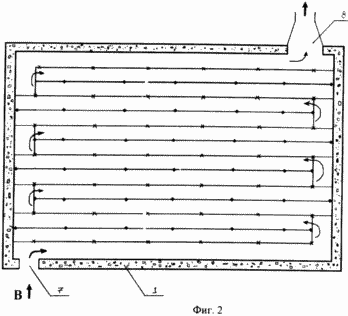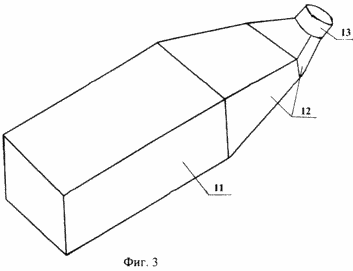| Start of section
Production, amateur Radio amateurs Aircraft model, rocket-model Useful, entertaining |
Stealth Master
Electronics Physics Technologies Inventions |
Secrets of the cosmos
Secrets of the Earth Secrets of the Ocean Tricks Map of section |
|
| Use of the site materials is allowed subject to the link (for websites - hyperlinks) | |||
Navigation: => |
Home / Patent catalog / Catalog section / Back / |
|
INVENTION
Patent of the Russian Federation RU2234034
![]()
SOLAR WINDOWS
The name of the inventor: Babayev B.D.
The name of the patent holder: Dagestan State University
Address for correspondence: 367000, Makhachkala, ul. M. Hajiyeva, 43a, DSU, UIS
Date of commencement of the patent: 2002.12.04
The solar wind power plant belongs to the field of solar engineering, or rather to installations for the use of non-traditional renewable energy sources - solar and wind. Can be used for power generation and air purification. The wind farm contains a solar collector with phase-transfer heat-accumulating material, above which there is a translucent gallery, communicated with an elastic translucent tube, spirally wound on a metal tube. The installation contributes to the stability of the wind turbine due to the accumulation of heat, maneuverability of energy supply through the regulation of airflow, the degree of use of renewable energy sources, reducing heat losses and energy costs.
DESCRIPTION OF THE INVENTION
The invention relates to solar engineering, or more precisely to installations for the use of non-traditional renewable energy sources - solar and wind. Can be used for power generation and air purification.
A device is known for creating natural traction with the help of solar energy [1], which contains a towing tower with a gap above the ground surface with a diffuser. The tower is made in the form of a corrugated sheath of absorbing solar radiation material and an elastic spiral tube fixed to it from an optically transparent material, the turns of which are fastened together. The tube has a variable in diameter diameter. The lower end along the perimeter of the tower rests on the ring diffuser, under which the compressor is located. The diffuser is fixed to the posts. The tube is connected to the compressor by means of pipes for supplying compressed air. For the vertical stabilization of the tower with its descents and ascents, ropes and winches serve.
The disadvantage of this device is the complexity of the design, high energy costs due to the use of compressor, ropes and winches, large heat losses and lack of heat storage capacity.
The closest in terms of technical essence is the solar wind turbine [2], which contains the installed at an angle ![]() Absorbing base located above it with the formation of an air cavity transparent coating, communicated with the cavity working channel and installed in the last wind power unit. The apparatus further comprises an absorbent surface with fins on both sides disposed in the cavity and the base is provided with alternating recesses and projections, the ribs on the base side oriented towards the working channel and on the coating side having solar reflecting surfaces. The coating has a sawtooth profile. The ribs come into contact with the base and the transparent coating.
Absorbing base located above it with the formation of an air cavity transparent coating, communicated with the cavity working channel and installed in the last wind power unit. The apparatus further comprises an absorbent surface with fins on both sides disposed in the cavity and the base is provided with alternating recesses and projections, the ribs on the base side oriented towards the working channel and on the coating side having solar reflecting surfaces. The coating has a sawtooth profile. The ribs come into contact with the base and the transparent coating.
The disadvantage of the known solar wind installation is the complexity of the design, the lack of control over the air flow, the instability of the exhaust due to the unevenness of the action of the sun, low accumulating and absorbing capacity, large heat losses.
The object of the invention is to increase the stability of the wind turbine operation due to the heat storage capacity, the possibility of regulating the air flow through the channel, and the reduction of heat losses and energy costs.
The technical result is to ensure sufficient absorption of sunlight, increase the stability of energy supply and the degree of use of renewable energy sources.
The technical result is achieved by the fact that the solar wind turbine includes a solar collector consisting of an absorbent base and a transparent covering installed at the foot of the mountain at an angle, a working channel communicated with its cavity and a wind turbine installed at the top of the mountain, the solar collector being made with a phase-transfer heat-storage material and communicating With a metal tube, with a translucent gallery located above the collector, which is communicated with an elastic translucent tube spirally wound on a metal tube, the tube and pipe being connected at the top of the mountain into one common channel on which an additional wind turbine is installed.

FIG. 1 shows a general diagram, a section.
 |
 |
2 - solar collector, plan; 3 illustrates the connection of a gallery from a transparent material
With a spiral elastic tube.
In Fig. The general scheme of a solar wind installation is presented. It contains a solar collector 1 consisting of a transparent cover 2, asphalt-concrete walls 3 and a base 4 made in the ground at the foot of the mountain, between the transversely corrugated wall 5 of the solar collector 1 and the asphalt-concrete base 4 is a phase-transfer heat-storage material 6. The solar collector 1 includes openings 7 Supply 8 and drain air into a metal pipe 9 which has a gate 10 and is laid along the mountainside to its top. A translucent gallery 11 is installed above the solar collector, which passes into an elastic tube 13 of a translucent material spirally wound on a metal tube 9, a tube 9 and a tube 13 on the mountain top are connected to a common channel 14 in which a wind turbine 15 is installed. The additional wind power unit 16 is installed at the top of channel 14.
2, in the plan of the solar collector, there are holes 7 for supplying air to the collector, movement inside the manifold in the inter-void space, and extraction of the hot air 8 into the pipe 9.
3 shows a translucent gallery 11 and a smooth transition 12 thereof into an elastic tube 13 of translucent material that is spirally wound onto a metal tube 9.
The solar wind turbine works as follows.
The solar radiation (I) passes through the translucent gallery 11, the transparent cover 2 of the collector 1 and is absorbed by the air in the gallery and the collector by the phase-transition material 6. Radiation reflected from the corrugated wall 5 containing underneath the phase-transfer heat-storage material 6 and from the asphalt-concrete base 4 and is absorbed Air in the intergonal space of the collector and gallery. With an excess of solar radiation, energy is expended on heating and melting the phase-transfer heat-accumulating material 6 in the corrugations, i.e. Is accumulated. During periods of absence of the sun, air is heated due to the heat released during the crystallization of the heat-accumulating material. Air passing from the bottom upward in the manifold 1, bypassing the corrugations and filling the space between them, as shown in Fig. 2 by arrows, is removed from above through the opening 8 of the manifold 1 into the tube 9.
Due to the difference in temperature and pressure of the air volume in the solar collector 1, the gallery 11 and the channel 14 creates an airflow in the pipe 9 and the tube 13, which then enters the wind power generating unit 15 that generates electricity. If there is wind at the top of the mountain, an additional wind turbine 16 is running from it, and the gallery 11 and the valve 10 are closed and solar energy is accumulated by the phase-transfer heat-storage material 6 in the collector 1. During the absence of the sun, gallery 11 closes and air passes only through the collector 1, The additional thrust is generated by the heat generated by the heat-storage material 6. The gallery 11 and the spiral elastic tube 13 serve as the thermal insulation of the solar collector 1 and the metal tube 9 and reduce the heat loss. The solar radiation, penetrating through the optically transparent wall of the tube 13 spirally wound on the metal tube 9, creates an additional thrust.
At the same time, the solar collector with phase-transfer heat-storage material, translucent gallery and spiral wound elastic tube on the metal pipeline, contribute to the stability of the wind turbine due to the accumulation of heat, maneuverability of energy supply due to the regulation of airflow, the degree of use of renewable energy sources, reducing heat losses and energy costs.
The air thrust created by solar energy can also be used to ventilate air polluted at the surface of the earth.
INFORMATION SOURCES
1. VMNozovkin, I.Z.Lutfulin and V.E. Khvan. Device for creating natural traction with the help of solar energy. - Author's certificate No. 979800, Cl. 3 F 24 J 3/02, E 03 G 7/02, bul. No. 45, 1982.
2. YM Belyaev. Solar Wind Turbine. - Author's certificate No. SU 1471756, F 24 J 2/42, F 03 D 9/00, publ. 1987
CLAIM
A solar wind turbine comprising a solar collector consisting of an absorbing base and a transparent cover and an operating channel installed at the foot of the mountain at an angle, communicating with its cavity, and a wind power unit installed at the top of the mountain, characterized in that the solar collector is made with phase-transfer heat-storage material and Is communicated with a metal pipe, while a translucent gallery is located above the collector, which is communicated with an elastic translucent tube spirally wound on a metal tube, the tube and pipe being connected at the top of the mountain into one common channel on which an additional wind turbine is installed.
print version
Date of publication 11.02.2007gg




Comments
When commenting on, remember that the content and tone of your message can hurt the feelings of real people, show respect and tolerance to your interlocutors even if you do not share their opinion, your behavior in the conditions of freedom of expression and anonymity provided by the Internet, changes Not only virtual, but also the real world. All comments are hidden from the index, spam is controlled.